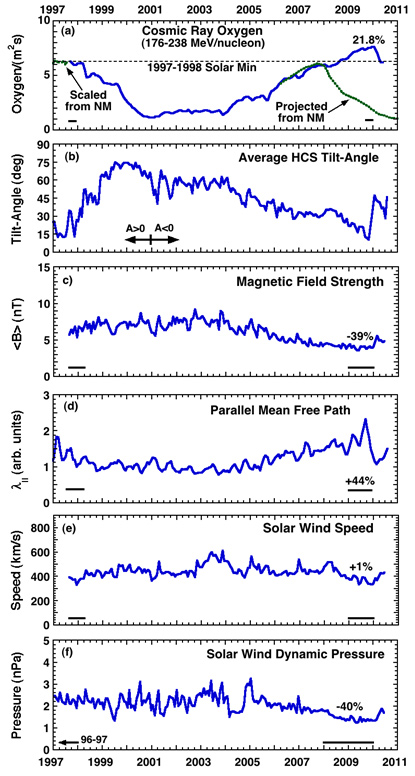Update on Record-Setting Galactic Cosmic Ray Intensities in 2009-2010
PDF version
 ACE News #122 (4/30/2009) reported that the intensity of galactic cosmic ray
(GCR) Fe at ~350 MeV/nuc, was ~12% greater in early 2009 than in 1997-1998 and
also greater than ever before in the space age. The measurements were made
with the Cosmic Ray Isotope Spectrometer (CRIS) on ACE. As 2009 progressed
the GCR intensity continued to increase until approximately New Years Eve,
when the intensities of major species from C to Fe were each 20% to 26%
greater than in 1997-1998 (e.g., oxygen in Panel (a) at the right). Early in
2010 the intensity decreased to 1997-1998 levels.
ACE News #122 (4/30/2009) reported that the intensity of galactic cosmic ray
(GCR) Fe at ~350 MeV/nuc, was ~12% greater in early 2009 than in 1997-1998 and
also greater than ever before in the space age. The measurements were made
with the Cosmic Ray Isotope Spectrometer (CRIS) on ACE. As 2009 progressed
the GCR intensity continued to increase until approximately New Years Eve,
when the intensities of major species from C to Fe were each 20% to 26%
greater than in 1997-1998 (e.g., oxygen in Panel (a) at the right). Early in
2010 the intensity decreased to 1997-1998 levels.
The elevated 2009 intensities measured by ACE [and by neutron monitors (NM)]
were undoubtedly due to several unusual aspects of the cycle 23/24 solar
minimum. During A<0 solar minima (when Sun's north polar field points
inward) GCR ions reach 1 AU mainly by drifting in along the Heliospheric
Current Sheet (HCS), and their path-length depends inversely on the tilt-angle
of the HCS. The HCS tilt-angle [Panel (b)] played a key role in modulating the
GCR intensity at 1 AU in 2007-2009 and the maximum intensities followed soon
after the minimum tilt-angle within 2-3 months. However, the minimum tilt was
less in 1987 (the last A<0 minimum) than in 2009.
More important factors were the record-low interplanetary magnetic field (IMF)
strength [Panel (c)] which was 39% lower than in 1997-98 (resulting in
correspondingly greater drift velocities), and an extended period of reduced
IMF turbulence. The estimated GCR scattering mean-free-path along the IMF
[λll - which scales as
B5/3/(δB2);
see Panel (d) and Zank et al. JGR 103, 2085,
1998] indicate that λll
was ~44% greater in 2009 than in 1997-1998. The
reduced scattering and increased drift velocities enabled greater GCR access
to the inner heliosphere in 2009.
The solar wind speed in 2009 was similar to that in 1997-1998 [Panel (e)], but
the solar-wind dynamic pressure [Panel (f)] was ~40% lower due to a reduced
solar-wind density. Although reduced dynamic pressure means that the size of
the heliosphere is now shrinking, this probably has a minor effect on cosmic
ray intensities at 1 AU because the intensity in the outer heliosphere depends
only weakly on radius.
In 2010 the intensities suddenly decreased to 1997 levels following increases
in solar activity, the HCS tilt-angle, and the IMF strength, and a decrease in
ll.
Since mid-2010 GCR intensities have been at 1997-1998 solar-minimum
levels. Although the 2009 intensities were at a 50-year high level,
measurements of 10Be deposited
in polar ice cores over the last ~500 years
(McCracken et al. Adv. Sp. Res. 34. 397, 2004) indicate that the space era has
occurred during a period of very-low GCR intensity. Between the years ~1400
and ~1900 10Be production
was typically ~40% to ~80% greater than in the early
1970s. It is possible that the near-Earth radiation environment is returning
to more "normal" conditions. For more information, see the paper by
Mewaldt et al. (2010) soon to appear in ApJ Letters.
This item was contributed by
Richard Mewaldt, Rick Leske & Ed Stone of Caltech,
Kelly Lave of Washington University, and Mark Wiedenbeck of JPL.
Address questions and comments to
Last modified 06 Oct 2010.
 ACE News #122 (4/30/2009) reported that the intensity of galactic cosmic ray
(GCR) Fe at ~350 MeV/nuc, was ~12% greater in early 2009 than in 1997-1998 and
also greater than ever before in the space age. The measurements were made
with the Cosmic Ray Isotope Spectrometer (CRIS) on ACE. As 2009 progressed
the GCR intensity continued to increase until approximately New Years Eve,
when the intensities of major species from C to Fe were each 20% to 26%
greater than in 1997-1998 (e.g., oxygen in Panel (a) at the right). Early in
2010 the intensity decreased to 1997-1998 levels.
ACE News #122 (4/30/2009) reported that the intensity of galactic cosmic ray
(GCR) Fe at ~350 MeV/nuc, was ~12% greater in early 2009 than in 1997-1998 and
also greater than ever before in the space age. The measurements were made
with the Cosmic Ray Isotope Spectrometer (CRIS) on ACE. As 2009 progressed
the GCR intensity continued to increase until approximately New Years Eve,
when the intensities of major species from C to Fe were each 20% to 26%
greater than in 1997-1998 (e.g., oxygen in Panel (a) at the right). Early in
2010 the intensity decreased to 1997-1998 levels.